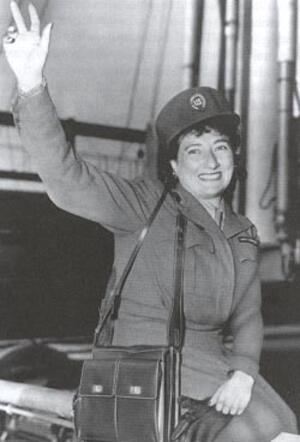Happy 101st Birthday to Ruth Gruber: Activist, Rescuer and Chronicler of her People’s Story
More than half a century after the August day in 1944 when Ruth Gruber coaxed reluctant refugees off the bus—told they would be taken to the showers, these concentration camp survivors refused to disembark—I stood on that very spot in upstate New York.
In the silence I could feel the spirit of the 982 men, women, and children who had somehow escaped the Nazis, could hear the raucous “mazeltovs!” under their makeshift chuppas, and see the children running home to their cabins after school. For nearly two years, these refugees shivered in the pitiless Lake Ontario winter, had babies, learned English and slowly, very slowly came back to life.
They were also destined to repay this country’s kindnesses many times over. Alex Margulis would help invent the MRI and CAT scans. Rolf Manfred would create the Polaris and Minuteman missiles. Walter Greenburg would win Academy Awards for special effects. Others would contribute in their own less documented ways to life here.
Now the little cabins stand empty, and it doesn’t take long to tour the modest museum.
The site itself in all its silence reminds us of a little known but proud moment in US history. It also recalls a young woman whom history cast in the role of rescuer, reporter, photographer, and all-around mistress-of-ceremonies for this very special mission: the only instance of the US initiating a wholesale rescue of Nazi victims.
The woman was pretty special herself. How many people today—much less someone born in 1911—earn Bachelor's and Master's degrees by age 19 and three (three!) Ph.D.s by 20? (No less than The New York Times reported that, at 20, Gruber was the youngest Ph.D. in the world.)
The serenity and safety of academia were not for her, however. By the following year, 1933, Gruber was traveling the world, reporting on international news. It was while writing for the New York Herald Tribune that she became the first foreign correspondent to fly through Siberia into the Soviet Arctic, a journey she recorded in I Went to the Soviet Arctic.
In 1935, continuing to report on world events, she received a fellowship to study women under fascist and communist rule. Word of Gruber’s work soon reached the ears of Secretary of the Interior Harold Ickes and, in 1941 he appointed her his Special Assistant. It was in this role that Gruber journeyed to Italy on a secret mission—bringing out 982 Holocaust survivors and escorting them to their new homes in Oswego, New York. During this brief break in America’s otherwise restrictive immigration policy during World War II, the refugees were welcomed as “guests” of President Roosevelt.
It was the opportunity of a lifetime, and the journalist and human rights activist halves of Gruber’s soul quickly seized the chance. On the ship, she put her German skills—one of her graduate degrees was in German lit—to work interviewing the passengers and recording dramatic stories of escape and survival. For many Americans, these stories would be the first inkling of the “backstory” of World War II, raising awareness of the plight of Hitler’s millions of victims, most of them Jews.
After World War II, Gruber continued to raise awareness of the plight of Jewish refugees. Her reports helped free those stuck in displaced person camps in Africa, Europe, and the Middle East and give them an opportunity to start life afresh in the new State of Israel. It was while reporting for the New York Herald Tribune that she learned that British forces in the Mediterranean had stopped the ship Exodus 1947, housing 4,500 Holocaust survivors.
In Haifa, she watched as British soldiers carried out the bodies of Bill Bernstein, the American second mate, and two 16-year-old orphans. The refugees were transferred to three prison ships, with the British assuring her they would be transported to Cyprus, where thousands of other survivors were imprisoned. She awaited the ships in Cyprus but they were diverted to a port near Marseilles, their original departure place. After three weeks, the British announced they were sending the Jews back to Germany and certain destruction. The terrifying photos Gruber took, as the sole American press representative allowed to witness the outcome, ricocheted around the world. And when her image of the swastika painted on the British Union Jack was featured as Life magazine’s Picture of the Week, it became an icon and a piece of the historical record.
She was 90 and in the midst of a 20-city book tour in 2001, when an interviewer asked Gruber to share the secret of her success. “Have dreams,” she said. “Have visions and let no obstacle stop you.”
A documentary about Ruth Gruber, Ahead of Time, was released in 2009. The film’s website includes a trailer and short film.







Hello,
Is there an archive with the writings of Rut Gruber? I‘m looking for the story of Moritz and Magrita Ehrenstamm, who were under the almost 1000 brought to Oswego. I‘m sure she wrote more about them than what is in her book „Haven“
Sincerely,
Klaus Duersch